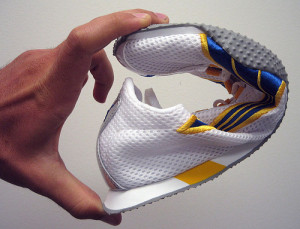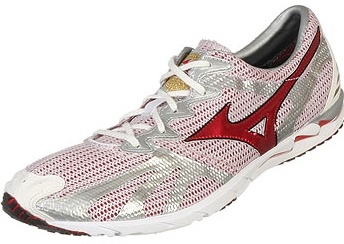The golden rule of learning forefoot running is to wear less on your feet. When I began my forefoot running journey, I started off doing so wearing the Puma-H Streets and I think you should consider doing the same (if you aren’t interested in the Vibram FiveFingers).
The problem I made in the beginning is that I wore minimalist running shoes that weren’t really minimalist in structure. For example, I wore the Nike Zoom which is inflexible, has minor arch support and other stability features which are no good for helping the feet strengthen and consequentially causes dysfunction in foot structure. These shoes also do not provide adequate shock absorption because the nerves in the feet can’t feel the ground, so our natural shock moderating behavioral responses are turned-off. At least in the Puma-H Streets, you can feel the ground, helping you execute the proper forefoot strike landing that will keep impact lower on the body.

Puma-H Streets Review for Forefoot Running
How can you make it as easy as possible to interact with the ground in a way where you will be able to feel your forefoot strike landing? Selecting a shoe, like the H-Street, that closely approximates being barefoot is what you need to do. That is, the lighter, the more flexible the shoe, with minimal cushioning and no support, the better you can sense the ground and land on the balls of the foot, not the heel.
I have worn the H-Streets for a year now, and my shin splints have disappeared. I feel lighter, more springier on my feet and that’s because I can feel the ground with more clarity. This is how the H-Streets help me produce a quicker withdrawal of my leg, giving me a better back-kick.
I first heard about the H-Streets after reading the Pose Method of Running, where the H-Streets were one of Dr. Romanov’s favorite minimalist running shoes. They are super lightweight and flexible because they have no absurd shoe technology. The upper is thick and meshy, so it is well-ventilated –it’s great for both summer and winter running. They are essentially a thin piece of rubber, very similar to the Vibram Five Fingers, except the rubber, grippy outsole on the H-Streets is slightly thicker, so if you’d rather not feel every pebble, I think you are better off with the H-Streets.
To me, the Puma’s are the most comfortable on my feet compared to the hundreds of minimalist shoes I have worn. Keyword being comfortable. They do come with a removable in sole. I take the insole out to feel the ground better and the shoe feels just as comfortable without the insole.
The right shoe for you should feel so comfortable that you don’t want to take them off, this is how I feel about the Puma H-Streets.
They feel like a snug, plush sock compared to other minimalist shoes I have experimented with, one being the Mizuno Universe Wave 3 (shown below) which has a more stiff outsole, and is actually designed for heel strike running:
 The Wave 3 was raved about how minimal it is, but really, it’s not that minimal. Plus, I found the sole to be too stiff and not compliant. In my opinion, the sole stiffness made the Wave 3 less responsive, so I ditched them.
The Wave 3 was raved about how minimal it is, but really, it’s not that minimal. Plus, I found the sole to be too stiff and not compliant. In my opinion, the sole stiffness made the Wave 3 less responsive, so I ditched them.
Never Frequently Change Your Running Shoes
I had habit of switching my running shoes frequently when I began forefoot running, but after a little research, I learned that you should stick to one pair only.
The problem with frequently switching shoes is the foot needs time to adapt to each shoe its exposed to. This adaptation period actually increases fragility of the foot and leads to pain, or even injury, not only exclusive to the feet, but the lower leg as well.
Therefore, if you are learning forefoot running, and experiencing localized pain here and there, don’t change your shoes, as this will only exacerbate pain.
Stick with a shoe that feels most comfortable, making sure you are still able to detect your foot-placement properly. And, be patient with pain, as the feet need time to adjust to any new shoe.
Hope this helps!
Please see my other reviews and recommendations on barefoot-type running shoes for forefoot running.
More From Run Forefoot:
Heel Strike vs Forefoot Strike
How Forefoot Running Improves Performance
Run Forefoot, You Are Faster than You Think!
Bretta Riches
BSc Neurobiology; MSc Biomechanics candidate, ultra minimalist runner & founder of RunForefoot. I was a heel striker, always injured. I was inspired by the great Tirunesh Dibaba to try forefoot running. Now, I'm injury free. This is why I launched Run Forefoot, to advocate the health & performance benefits of forefoot running and to raise awareness on the dangers of heel striking, because the world needs to know.
Latest posts by Bretta Riches (see all)
- Are Minimalist Shoes Good for Seniors? YES! - 14/04/2024
- BIG Deals On Running Gear And More! - 09/04/2024
- Why Are My Feet Tired After Running? - 04/04/2024

Leave a Reply